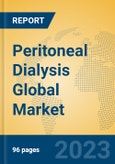Market Size and Growth Forecast
The global peritoneal dialysis market is projected to reach between USD 5.0 billion and USD 9.0 billion in 2025, with a compound annual growth rate (CAGR) of 5% to 10% through 2030, reflecting the increasing adoption of home-based dialysis treatments and the growing emphasis on patient-centered renal care approaches.Regional Analysis
- North America: The United States leads with advanced renal care infrastructure and strong emphasis on home dialysis programs, while Canada focuses on expanding peritoneal dialysis access and improving patient outcomes through comprehensive support programs.
- Europe: Germany, France, and the United Kingdom dominate the region, driven by established renal care networks, favorable reimbursement policies for home dialysis, and strong clinical evidence supporting peritoneal dialysis benefits for patient quality of life.
- Asia Pacific: China and India demonstrate rapid growth due to increasing chronic kidney disease prevalence and expanding healthcare infrastructure, while Japan emphasizes advanced peritoneal dialysis technologies and comprehensive patient care programs.
- Rest of the World: Brazil enhances peritoneal dialysis capabilities through improved healthcare access and clinical training programs, while the Middle East, particularly the Gulf countries, invests in advanced renal care technologies and specialized nephrology services.
Application Analysis
- Home Health Care: Expected growth of 6.0-11.5%, driven by patient preference for home-based treatment and healthcare cost containment initiatives. Trends focus on automated systems, remote monitoring capabilities, telemedicine integration, and comprehensive patient education programs supporting successful home dialysis management.
- Hospitals: Projected growth of 4.5-9.0%, linked to acute kidney injury treatment, peritoneal dialysis initiation protocols, and complications management. Developments emphasize standardized procedures, infection prevention measures, and transition-to-home programs ensuring continuity of care.
Type Analysis
- Continuous Ambulatory Peritoneal Dialysis (CAPD): Expected growth of 4.0-8.5%, valued for simplicity and patient independence without machine requirements. Trends focus on improved dialysis solutions, enhanced bag systems, and patient training programs optimizing treatment outcomes and quality of life.
- Automated Peritoneal Dialysis (APD): Projected growth of 6.5-12.0%, key for patient convenience and precise fluid management. Advances highlight smart cycler technologies, wireless connectivity, remote monitoring capabilities, and user-friendly interfaces improving treatment compliance and clinical outcomes.
Key Market Players
Leading firms include Fresenius Medical Care, providing comprehensive peritoneal dialysis solutions and global clinical support services; Baxter, leading peritoneal dialysis innovation with advanced cycler systems and dialysis solutions; Medtronic, integrating advanced medical technologies with renal care solutions; DaVita, offering comprehensive kidney care services and home dialysis programs; BD, providing medical devices and infection prevention solutions; Utah Medical Products, specializing in women's health and neonatal care devices; Terumo Corporation, developing advanced medical devices and healthcare solutions; Diaverum, focusing on renal care services and treatment excellence; Medionics, providing specialized medical devices and renal care technologies; Renax Biomedical Technology, innovating in renal replacement therapy solutions; and JMS, offering medical devices and pharmaceutical products. These companies drive market growth through product innovations, clinical evidence development, patient support programs, and expanded global distribution networks supporting comprehensive renal care.Porter's Five Forces Analysis
- Threat of New Entrants: Moderate, due to established clinical relationships, regulatory requirements, and significant capital investments required for manufacturing and distribution, though innovative companies can enter with specialized technologies or regional focus strategies.
- Threat of Substitutes: Moderate, as hemodialysis and kidney transplantation provide alternative treatment options, though peritoneal dialysis offers unique advantages including patient independence, lifestyle flexibility, and cost-effectiveness for appropriate candidates.
- Bargaining Power of Buyers: Moderate to high, with healthcare systems and patients seeking cost-effective, convenient solutions while maintaining clinical quality standards and comprehensive support services for successful treatment outcomes.
- Bargaining Power of Suppliers: Low to moderate, due to multiple component suppliers, raw material providers, and manufacturing options, though specialized dialysis solution manufacturing may create some supplier concentration.
- Competitive Rivalry: Moderate to high, with companies competing on product quality, clinical outcomes, patient support services, cost-effectiveness, and comprehensive care programs while building strong relationships with nephrology practices and healthcare systems.
Market Opportunities and Challenges
Opportunities: The increasing prevalence of diabetes and hypertension, primary causes of chronic kidney disease affecting over 500 million people globally, creates substantial demand for renal replacement therapy options. The growing emphasis on value-based healthcare and cost containment drives adoption of home-based dialysis modalities offering economic advantages over in-center hemodialysis. Technological advances in automated peritoneal dialysis systems, including smart monitoring, artificial intelligence integration, and mobile health applications, offer opportunities for improved patient outcomes and treatment compliance. The expanding geriatric population, with individuals over 65 representing the fastest-growing demographic requiring renal care, presents significant market growth potential. Emerging markets demonstrate increasing healthcare infrastructure development and growing awareness of chronic kidney disease management options.Challenges: Peritonitis and other infection-related complications remain significant concerns, requiring continuous product improvement, comprehensive patient education, and rigorous infection prevention protocols to ensure treatment safety. Limited patient suitability due to abdominal surgery history, physical limitations, or social factors restricts the potential patient population eligible for peritoneal dialysis treatment. Healthcare provider preference for hemodialysis and limited peritoneal dialysis training in some regions may slow adoption rates and limit patient access to optimal treatment options. Complex patient training requirements and ongoing support needs increase operational costs and resource requirements for healthcare providers and manufacturers. Inadequate reimbursement coverage in certain regions restricts patient access to peritoneal dialysis and limits market growth potential. The need for reliable supply chains and cold storage requirements for dialysis solutions creates logistical challenges, particularly in remote areas and developing markets with limited infrastructure.
This product will be delivered within 1-3 business days.
Table of Contents
Companies Mentioned
- Fresenius Medical Care
- Baxter
- Medtronic
- Davita
- BD
- Utah Medical Products
- Terumo Corporation
- Diaverum
- Medionics
- Renax Biomedical Technology
- JMS








